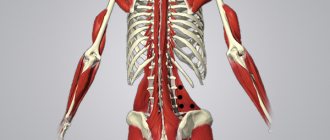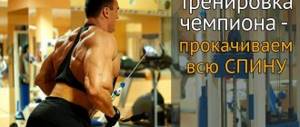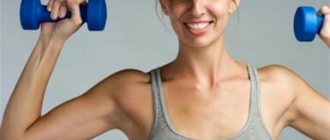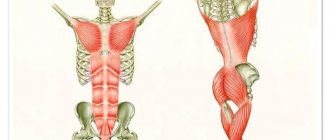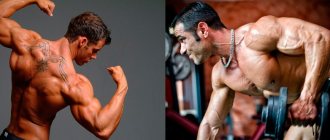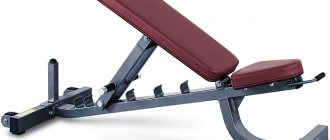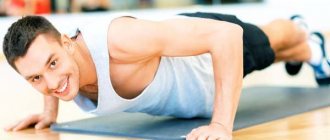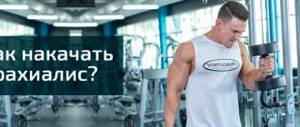Bret Contreras
Strength Coach and Performance Expert
To pump up the gluteal muscles, you need to meet two conditions: load them quite heavily (and increase the load over time) and learn to mentally concentrate on the working muscle.
Start your workout with a “heavy” exercise that allows you to move heavy weights—such as a barbell squat, Romanian deadlift, sumo deadlift, deadlift, or platform leg press. Keep a training diary and regularly record your progress in these exercises - weights, sets, repetitions. It is important to get enough rest between sets.
Finish the workout with lighter, isolation exercises such as frog pumps with dumbbells, glute bridges with a resistance band around the knees and dumbbells, hyperextensions without weights and the like.
Do more repetitions of these exercises and rest less in between. You don't have to count reps, but it is important to engage your glutes as you work and focus on the quality of each rep.
The combination of these two approaches allows you to work on your glutes with maximum impact.
What determines the volume of the buttocks?
The muscles of the buttocks support the spine. The gluteus maximus muscle is the largest human muscle. It is this that forms the shape of the pelvis, which depends on several points:
- The gluteus maximus muscle needs to be properly trained. This helps to tighten the buttocks. Gives them elasticity.
- Excess fat in the buttocks area only hinders the results. You need to get rid of it: limit yourself to the consumption of certain foods, perform cardio exercises in combination with strength training.
- Women are genetically predisposed to fullness in the hip area. The shape of the buttocks also depends on genetics: heart-shaped, pear-shaped, oval, flat. Training will help girls change the ratio of subcutaneous fat to muscles. The size of the buttocks can also change. However, the shape of the butt itself directly depends on genetics. It should also be remembered that the athlete needs to experiment with sets of exercises in order to be able to determine the most effective ones specifically for himself and his body.
Bronwen Blunt
Nutrition and Strength Coach
You can't build a house without a foundation, so start with the "big" compound exercises - squats, deadlifts.
I see a lot of bikini athletes doing endless glute isolation and completely neglecting compound exercises in their programs.
You won't build big, round buttocks by sitting on machines and doing endless reps all day. Build the foundation first, and after that, all other exercises will be more beneficial for your figure.
The three main exercises for strengthening and growing the buttocks are barbell squats, sumo deadlifts, and Bulgarian split squats.
Try adding some manipulation to your exercises to further challenge your muscles. For example, hold the glute contraction for 3-5 seconds at the top of the sumo lift at the end of each rep, or increase the negative phase (lowering the weight) to 5 seconds.
Paul Carter
Strength and Bodybuilding Coach
Stop relying on squats and deadlifts alone to build your glutes. They are "activated" during these complex movements, but for most people this is not enough - the leg muscles often do a lot more work.
Of course, for some, squats and deadlifts may be enough to get well-developed gluteal muscles. But most people will need more work.
What is the function of the gluteal muscles? The gluteus medius is responsible for stabilizing the hip and knee when we stand on one leg, as well as abducting the hip to the side. Therefore, split squats and flyes in a seated machine are not such a bad idea.
For split squats, pause at the end of each set for about 10 seconds without fully extending your leg—this will cause your gluteus medius to burn. You can also do back lunges with dumbbells and yes, you can do them in a Smith machine too.
When it comes to hip abduction, some say it's not functional, but if you want to build a big round butt, they work great. Just use them correctly: hold a pause of 5 seconds at the end of each repetition and do the eccentric phase (lowering the weight) for 5 seconds as well.
When you reach failure, do 5 forced repetitions, helping yourself with your arms. Do 3 sets of 15 reps like this, plus 5 forced reps at the end of the set, and tell me if your glutes don't get destroyed.
As for the gluteus maximus muscle, its main job is hip extension. The glute bridge is great, but most people use too much weight, which prevents full hip extension and maximum gluteal contraction.
So it's better to go with a lighter weight and do 20 reps with a 3-second pause at peak contraction on each rep to better activate your glutes and extend your time under load rather than go for a world record weight.
Make sure your toes and knees are slightly turned outward to help contract your glutes as much as possible.
Weak buttocks as a cause of arthrosis, lower back and neck pain
Many are sure that well-developed gluteal muscles are only important for the beauty of a woman’s figure. And they don’t suspect that decreased tone of the buttocks is the root cause of many problems with the spine and leg joints , regardless of gender. Read more about the functions of the gluteal muscles, and how to properly strengthen them for the benefit of the health of the musculoskeletal system, in our new article.
The gluteal muscle is one of the largest in our body, and for good reason. The functionality of this muscle, as a part of the musculoskeletal system, is much broader than giving the “fifth point” a beautiful shape and roundness.
The gluteal muscle is actively involved when walking - in pushing the leg during each step, stabilizing the body and legs in a standing position, and even when we climb stairs, lean forward and even when sitting, since the pelvis in this case becomes the basis that supports the spine anatomically in the right position.
However, in modern humans, the gluteal muscles, as a rule, are weakened, since we move little, use the elevator instead of walking up the stairs, and sit for a long time without active movement. As a result, the butt grows and the muscles weaken. And it turns out that one of the most powerful and strong muscles in our body, over time, loses its tone so much that it almost completely turns off from movement. What does this mean?
What are the dangers of weak buttocks?
Everyone needs strong buttocks - these are the muscles that give us the opportunity to move, sit straight, without overstraining the spine.
Now imagine that the gluteal muscle is weakened and does not fully perform its functions. Then compensation mechanisms are triggered, and the gluteus maximus muscle is replaced by its synergists - those muscles that participate with it in any movement, they take on its load . First of all, the joints of the legs and the lumbar spine begin to experience increased stress when walking, and when sitting, the cervical spine begins to experience increased stress.
Buttocks and legs
If the gluteal muscle is weakened, then when pushing with the foot while walking, the muscles of the back of the thigh or the calf muscle are overstrained. The legs get tired faster, the venous and lymphatic outflow from the lower leg and calf area is disrupted, and this is the path to arthrosis of the hip and knee joint (coxarthrosis and gonarthrosis).
An example from a practicing kinesiologist
. The patient constantly experienced pain in the calf muscle after running and even normal walking. Seeing doctors and treating the lower leg (massage, ointments, creams) did not yield results. The pain went away for a while and returned again. After conducting manual-muscular diagnostics, the kinesiologist found out that the cause was weakness of the gluteus maximus muscle (GMM), which caused the calf muscle to become overly tense and painful. After strengthening the BMN and restoring its function, the pain stopped.
Buttocks and neck
A case from the practice of a kinesiologist
. Complaints: neck pain, tense muscles. Classic drug treatment was aimed at reducing pain in the cervical spine. After conducting manual-muscular diagnostics, it turned out that pain and discomfort in the neck occurs only when a person is sitting. What does this mean? The reason is a decrease in the tone of the gluteal muscle, as a result, instability of the pelvis, and as a result, the gluteal muscles cannot fix the pelvis, the person sits incorrectly, so the neck muscles are overloaded.
Buttocks and pelvic distortion
Weak buttocks cause pelvic distortion. And the pelvis is the bony floor of the spine, and any, even minor, change in the position of the pelvis (displacement, distortion) causes a disruption in the biomechanics of movement, increased load on certain areas of the spine, and, as a result, can lead to postural disorders and degenerative changes in the spine , to disc herniation, scoliosis, osteoarthritis, spinal canal stenosis, etc.
Buttock and lower back
The main antagonist of the psoas muscle is the gluteus maximus muscle. When walking, the gluteal muscle, contracting, moves the leg back, and the lumbar muscle helps to move the leg forward. Walking is essentially alternate contraction and relaxation of the gluteus maximus and psoas muscles.
The worse the gluteus maximus muscle works, the more the psoas muscle shortens. And the shorter the psoas muscle, the more difficult it is to work the gluteus maximus. It turns out to be a vicious circle. Therefore, with weak buttocks, as a rule, there is also a weak lower back.
Why is this dangerous? Every step you take without the participation of the lumbar and gluteal muscles is the destruction of the cartilage of the hip joint, microtrauma of the intervertebral discs in the lumbar spine, the risks of developing protrusion and disc herniation.
That's how important the gluteus muscle is.
How do you know if your gluteal muscle is weak?
This cannot be done with the help of a visual examination, and even with the help of devices - MRI, CT, ultrasound or x-ray. Weak muscles do not manifest themselves in any way externally and even by pain, since it is not they that hurt, but those muscles that compensate for them, take on an increased load, overstrain and spasm.
Only an experienced specialist in the field of applied kinesiology can find the weak link in the body, who conducts a manual muscle test of the whole body, all muscles, and in different positions, while walking, sitting, lying down, bending over, lifting arms and legs, testing muscle-tendon reflexes under tension. Only after a weak, dysfunctional muscle has been identified can an effective treatment program be developed that will be aimed at restoring its strength and tone. This is the only way to truly get rid of problems - pain in the lower back, neck, joints, inflammation, stiffness, progressive osteoarthritis, disc herniation, poor posture.
How to get your gluteal muscle back into action?
There are many exercises to strengthen the buttocks, both basic, for example, a deep squat (below parallel with the floor), and isolated using exercise machines. And fitness clubs even conduct special group programs for pumping up the buttocks.
But it is important to know that if you already have problems with the lumbar region (it is weakened, there are protrusions, hernias), and leg joints, then forceful loading on the buttocks can do more harm than good. If your buttocks are weak, you should not do weight training on your legs at all . Squats are contraindicated. Running is no less dangerous, including on cardio tracks. It’s so easy to avoid coxarthrosis and hernia in the lower back.
Therefore, first of all, it is necessary to restore the basic function of the gluteal muscles with the help of special therapeutic exercises on rehabilitation complexes - kinesiosimulators. These simulators are designed in such a way that they allow certain muscles to be activated in isolation and in doses (under control), without loading others, and without axial load on the spine and joints.
This allows you to safely load the deep skeletal muscles of the joints and spine. In the case of the gluteal muscle, work is simultaneously carried out on the muscles of the lumbosacral region and the back of the thigh, which, as a rule, are also weakened.
A course of treatment using kinesiosimulators allows you to solve several problems at once:
– strengthening weakened muscles, stretching shortened and overloaded ones, restoring the functions of skeletal muscles, the balance of weakened and tense muscles,
– relief of muscle spasms, inflammation of periarticular muscles – a source of pain and discomfort,
— restoration of nutrition in the area of the affected disc or articular cartilage (lymph drainage, blood supply, innervation) by activating deep skeletal muscles, which triggers natural mechanisms of regeneration of osteochondral tissue
. The herniated disc may become minimal and even disappear completely.
- formation and strengthening of the muscle corset, which supports and nourishes the spine, joints,
— formation of new correct biomechanics of movement to prevent relapse of pain in the future. The kinesiotherapist selects special exercises for the muscles and “retrains” them to move correctly.
— Correction of posture – scoliosis, hyperkyphosis, stoop.
Specialist consultation is required.
Doctor’s consultation + diagnostics using applied kinesiology – 1000 rubles.
Call, write! Tel.: (843) 570-55-25 , WhatsApp: 79655968085 or VKontakte group .
Read us on Yandex Zen:
Follow us on Instagram:
Don't miss out on the fun! Subscribe to our news:
Subscribe to news from the Kazan Kinesitherapy Center
Center promotions, therapeutic exercises and useful tips from our specialists on how to independently maintain the health of your joints and spine without medications
Similar articles:
Therapeutic massage at the Kazan Kinesitherapy Center
Rheumatoid arthritis. Autoplasmotherapy will help!
Free diagnosis of the spine and joints + doctor’s consultation
Tony Gentilcore
Strength Coach and Performance Expert
The answer is simple: whatever Bret Contreras advises is the best way to build a bigger glute.
The important thing here is not to be too “absolutist” in the exercises you gravitate towards. Some will say that for larger butts you need to do only glute bridges. Others will say that the only thing you need are heavy squats and deadlifts.
Actually, everything works. In the gluteal bridge, the muscles are maximally loaded in a reduced form. In squats and deadlifts - at the moment of stretching under load.
These are all important components to glute development, so stop arguing over semantics and realize that different things work differently. Try incorporating both into your program.
One of the protocols I use with my female clients is called the 5-10-15-20 method. The idea is to do four glute exercises, increasing the number of repetitions of each in sequence.
Workout A
1. Heavy squats or deadlifts - 5 reps per set
2. Kettlebell swings - 10 reps per set
3. Single leg glute bridge - 15 reps on each leg
4. Seated hip raises with band - 20 reps
Workout B
1. Heavy Glute Bridge with Barbell - 5 reps per set
2. Goblet Squats - 10 reps
3. Elevated Back Lunges - 15 reps on each leg
4. Side steps with band x 20 reps on each leg
- Do one exercise after another with minimal rest.
- “Heavy” exercises should not be performed to failure.
- Rest 60 seconds at the end of one circuit and repeat 2-3 circuits.
Do this twice a week.
Gluteal muscles
The leg muscles, including the gluteal muscle, span three joints: the hips, knees and ankles.
The large leg muscles play a major role in supporting the hips and core—including the pelvic area and lower back muscles, some of the most susceptible to pain. Strong gluteal muscles also allow for movements such as bending over, squatting, standing upright, pushing off the ground (for example, to run) and to support other aspects related to proper posture. A 2005 report published in the journal Biology found that the human gluteus is a distinctive muscle in terms of size, anatomy and function compared to monkeys and other non-human primates. Enlargement of the gluteal muscle was likely important in the evolution of hominin running ability.
If your lower body feels weak or tight, a dynamic workout that targets all leg muscles will improve range of motion and increase stability, helping prevent compensation and injury.
What is the Gluteus Maximus (gluteus maximus)?
The gluteal bone is one of the three gluteal muscles and one of the largest muscles in the entire body.
While many people think of the gluteal muscles as a single muscle (the gluteus muscle), they are actually a group of three muscles: the gluteus maximus, gluteus medius, and gluteus minimus. The gluteal bone is the largest of the gluteal muscles and supports the other two gluteal muscles in a variety of ways. In people who are quite active, the gluteal muscles are usually one of the strongest muscle groups in the entire body, due to the need to support the sacrum and femur, the areas of the lower and middle body where the gluteal muscles attach.
Together, the gluteal muscles help with exercises such as: squats, pushing, stair climbing, jumping, and lower body balancing. For overall most functional lower body strength, the glutes are trained in proportion to the other leg muscles, including the quads
and caviar.
What do the gluteal muscles do?
The primary role of the gluteal muscles (gluteus maximus) is to maintain pelvic stability and expand or rotate the hips. Some of the benefits of having stabilized, strong maximus gluteal muscles include:
- Help with running and other higher intensity activities that involve lifting
- some studies have found that while the gluteal bone supports lower levels of activity (such as walking uphill or on level ground) in certain respects, this strength is required much more more for activities that require speed, such as jumping or running. In fact, some researchers believe that the growth of gluteal muscles in humans and other primates is linked to the evolution of running ability. - Stabilizing the Pelvis and Supporting the Hips
– In order for weight and strength to be properly balanced in the body, moving upward from the lower legs to the upper body, the hips must be stable. Strong gluteal muscles help prevent muscle compensations and eliminate weak hip muscles that can contribute to injury or poor performance. - When supporting back muscles
in patients who complain of lower back pain, many experts recommend strengthening the gluteal muscles to improve posture and relieve pressure on the lower body.
Low back pain
is one of the most common complaints among middle-aged and older adults, often associated with
too much sedentary activity
, too little lower body movement, and not enough stretching. - Femur Stabilization (femur)
- The femur connects to the hip joint, which is supported at the back by the gluteal muscles. The gluteal muscles help rotate the hip, both internally and externally.
Gluteal region
The gluteal muscles are located behind the pelvic area, attaching to the fascial tissue of the lumbar region (lower back).
They sit below the gluteal bone (upper part of the buttocks) and above the biceps femoris (muscles in the back of the thighs). They also connect to the sacrum, sacral ligament and coccyx. The gluteus maximus attaches to the front of the legs by inserting into the gluteal tuberosity of the thigh. Another insertion point is the iliotibial tract, which connects to the tibia. The nerve supply that reaches the gluteal muscles is called the inferior gluteal nerves.
Common gluteal injuries
The gluteal muscles are one of the main muscles in the body that are usually involved in improper training or injury due to poor form.
The gluteal muscles can sometimes contribute to imbalances in the body or overuse injuries when they are used and strengthened too much in relation to other muscles such as the quadriceps (the muscles at the front of the thighs). All leg muscles are more prone to overuse when performing repetitive movements; this may be one behavior associated with overtraining, especially without proper rest
or when not doing enough stretching between workouts. Gluteal injuries are most often caused by repetitive leg movements that require movement in only one direction or plane.
On the other hand, the gluteal bone (and other gluteal muscles) can also become weak and unstable when someone doesn't get enough
physical activity, for example if they sit for many hours a day at a desk and live a largely
sedentary
lifestyle. Some experts call this phenomenon "gluteal amnesia," which occurs when the muscles near the buttocks become overtight and underused, leading to weakness and stiffness. Some common aches, pains and bruises associated with weak gluteal maximus muscles may include:
- Lower extremity injuries
- Some research suggests that weak gluteal muscles may increase the likelihood of injury to other parts of the legs due to instability. This could include bruising your knees, for example. - Hip pain -
The gluteal bone plays an important role in stabilizing the pelvis, so when the muscle is weak or injured, poor balance can develop. This can lead to hip tightness or hip flexor pain, especially if you also skip stretches. The hips may not be able to rotate properly, which can compromise proper form in other muscles. - Reduced pelvic stabilization
- this may increase the risk for
bruises
, lower back pain and leg pain (like hamstrings). One side of the body may become stronger or more balanced than the other, increasing the likelihood of injury. - Low back pain
– The gluteal muscles help the body properly perform multi-faceted movements that can strain the back, such as bending or squatting. By helping the torso, pelvis, hips and legs remain evenly balanced and stable, the body can move in dynamic ways without overextending or rounding one specific area of the spine due to gravity. - Trouble walking, running, or performing other activities
—any physical movement that involves stability, flexibility, and strength in the legs and hips may be compromised.
For example, yoga, dancing, horseback riding, cycling, sprinting, plyometrics or Tabata workouts
and other activities will be more difficult with underdeveloped gluteal muscles. - Reduced range of motion during normal activities
Exercises for growing gluteal muscles
For best results, perform the following glute-building exercises three to four times a week.
You can either aim for a certain number of repetitions (eg 10-20 repetitions, depending on your fitness level) or perform the exercises in a circuit, performing each exercise for 45-60 seconds with a 15-second break. For beginners, perform two sets in total. And for advanced ones, aim for a total of three to four sets. Between each exercise cycle, give your muscles a break, resting for about 1-2 minutes. To build strength evenly and prevent overuse, give yourself plenty of rest throughout the week and also incorporate other back and upper body exercises.
Mark Dugdale
IFBB Pro Bodybuilder
My best advice for anyone who wants strong, great-looking glutes is to start every leg workout by activating and pre-exhausting your glutes. You'll see they perform better throughout the rest of your workout.
Here are a few of my top suggestions for butts:
- Glute Bridge: Pause each rep for 2 seconds at peak muscle contraction.
- Split squats with one leg on the bench: do drop sets (reducing the working weight several times per set as the muscle fatigues) with a pause of a few seconds at the end of the set.
Prowler push: Take long, slow, deliberate strides using moderate weights on a sled.
Try starting every leg workout with one of these exercises. Alternate between them because they all activate the glutes differently.
Lee Boyce
Strength Coach and Performance Expert
Sprinting is one of the best ways to target the entire posterior kinetic chain, including the glutes. Take some time to learn how to do it technically.
I like step lunges with dumbbells because of their one-sided load. You can vary your step width to better target your glutes: taking longer steps and leaning your torso forward can create more impact. Dumbbells are the best option for this exercise because they reduce stress on the lower back.
Finally, we can't talk about glutes without a glute bridge. The problem people have is lifting too much weight and doing it like a lifter. If you lift too much weight, you won't be able to hit your glutes in isolation—other muscles in your body will come in to help with the heavy load. So reduce the weight and do more repetitions, concentrating on the muscles.
Let's not be biased
1. The gluteal muscles can actually weaken.
But this happens to many muscles when we feel pain or are sedentary. Weakness certainly affects some injuries and results achieved.
2. Is it possible to somehow “turn on” the gluteal muscles if their passivity bothers someone?
Greg Lehman believes so, although he repeats once again that it is quite possible to move normally without the active participation of the gluteal muscles. When we pick something up from the floor, we can do it with a knee-dominant or pelvic-dominant technique. Select the option you need. It's simple. And there is no need to talk about dysfunction.
3. Is strengthening the gluteal muscles beneficial?
Training generated by the fear of “dead ass syndrome” is better than no training. Increasing physical activity, strengthening exercises for the hips, back and legs, often involves changing postures or movements to relieve certain symptoms - this is usually not harmful. In addition, hip strength exercises have been proven to be beneficial for people with knee pain.
However, the clinical success of the exercise does not prove its mechanism of action. Instead of imagining that exercise will release the glutes, we can re-evaluate this approach to treatment. If someone has lower back pain when bending, it is wise to train them to lift weights or move with less bending at the waist. This will require more stress on the hips (hip hinge), and to learn a new movement pattern, you will have to do exercises that engage the glutes and move the spine less. As a result, a person will learn to avoid positions in which he feels pain and do exercises that help him with this. Teaching a person to move differently and changing the load on the hip extensors is a great opportunity to relieve stress on the knee and spine and help the person move without pain. But this does not prove the existence of pathology of the gluteal muscles
Let's repeat it again. These individuals did not have impaired gluteal muscle activation. They were simply asked to temporarily abandon the painful position and taught the appropriate exercises. That's all.
This approach is not new. We have already seen this shift from “correcting” perceived dysfunction to simply changing symptoms and maximizing function in virtually all other joints. For example, in the shoulder.
Christian Thibaudeau
Strength Coach and Performance Expert
If you want to improve the shape of your glutes, learn to incorporate them into compound, compound exercises—particularly squats, which can be very effective when done correctly.
The problem is that most people use their front thighs more than their glutes when squats. Try turning your hips and knees outward without lifting your feet off the floor. Imagine trying to screw your legs into the floor—the right one clockwise, the left one counterclockwise. This will help activate your glutes better and improve tension in them.
Throughout the entire movement - both when we lower and when we rise - we need to maintain this “spiral” tension. If you lose it, the body will revert to its normal way of lifting weights and shift the load to the quadriceps.
In the beginning, this may require you to lighten your weights and slow down your tempo to learn how to maintain tension. Once this becomes automatic, squats become more effective because you are now using two large muscles equally instead of just one.
To really focus on your glutes, use suspended squats: pausing for 2-3 seconds at the bottom of each rep. The key is not the pause itself, but what you do during it:
- Pause a few inches before you reach your bottom position in the squat.
- During the pause, maintain spiral tension.
- Stand up straight from the suspended position. Don't go down and bounce up by inertia.
This is my favorite technique for maximizing glute engagement in squats. Of course, it can only be used after you have learned how to properly create spiral tension.
An effective exercise for the gluteal muscle
An effective exercise for the gluteal muscle is much more effective than all isolation exercises.
Among the basic ones, it is better than classic squats, more effective than deadlifts. These exercises are not bad in principle, but the exercise we will analyze today is ideal. And we will analyze the mistakes that people make in this exercise and therefore cannot achieve a positive effect. An effective exercise for the gluteal muscle - lunges in different variations
: lunges in motion, lunges with a barbell, reverse lunges in a Smith machine.
Lunges with dumbbells in motion -
wide step:
Lunges with a barbell in motion:
Smith Lunges:
The best option is lunges in motion. Because when you push off with your supporting leg, the gluteal muscles work best. This exercise achieves a very powerful stretch of both the gluteus maximus and gluteus minimus muscles. And their work is powerful, because this is a basic exercise and the entire body weight falls on the thigh and buttocks. This exercise gives a lasting effect.
The most effective exercise for the gluteal muscles - basic mistakes
Step too short:
In this case, the projection of the center of gravity occurs on the center of the thigh. The main load falls on the quadriceps, some falls on the hamstrings. As a result, basically only the quadriceps is involved in the work, the buttock works very weakly. It is important that the step is wide. With a wide step, the center of pressure will be in the area of the hip joint. With a wide step, you will ensure that the buttocks work powerfully, not the quadriceps.
Forward tilt:
You shift the center of gravity from the hip joint to the quadriceps.
Transferring body weight to the toe:
Instead of leaning on the heel, a person gets up from the toe. We rely only on the heel when we stand up. And then the center of gravity falls on the hip joint and the gluteal muscles work perfectly.
Another important point when you perform lunges in motion is not to strain your back leg. There is no need to try to push her too much, to keep her in tension. The back leg is relaxed, the front leg is tense.
If you do everything correctly: take a long step, lean on the heel, do not lean forward in this body position, working in the 10 repetition range with the appropriate weight on each leg, you will get a powerful response to the gluteal muscles.
By performing the most effective exercises for the gluteal muscles, you can pump them up even without resorting to other exercises. If you lack buttocks, do this exercise.
Final Thoughts on the Gluteus
- The gluteus muscle is one of the three gluteal muscles and is one of the largest and strongest muscles in the entire body.
- The functions of the gluteal muscle include helping to stabilize the pelvis, supporting the hips, protecting the lower back, and assisting with movements such as running, pushing, or squatting. Weak gluteal muscles can contribute to leg injuries, poor balance, hip and lower back pain.
- Glute exercises and stretches to prevent weak or tight glutes include: all types of squats and lunges, Romanian deadlifts, glute bridges, etc.
Dr. John Rusin
Strength Training Specialist and Performance Expert
People lift too much weight on the glute bridge in pursuit of its effectiveness and risk damaging their backs. Due to the lack of axial load, you can make a huge number of mistakes that cause problems in the lower back. It's a dynamic movement, and when it's poorly controlled and uses too much weight, the work doesn't happen as much in the glutes. Very often, people compensate for the upward push of the barbell by using their lower back, losing stability in the back and muscle control.
The gluteal bridge should be done with control of movement, with a pause in the upper position, from 8 repetitions and above. The glutes are the primary stabilizers of the pelvic-lumbar complex and can protect you throughout your life, so train them accordingly.
Eric Bach
Strength Coach and Performance Expert
To build strong, great-looking glutes, you need to combine two training factors: high mechanical stress and metabolic stress.
Build a foundation with exercises that allow the muscles to develop a lot of mesonic tension—squats, deadlifts, and, of course, glute bridges. Do 3-5 sets of 3-8 reps and add weight to the bar over time. This will help you engage your fast-twitch muscle fibers as much as possible.
This is followed by exercises to create metabolic stress in the muscle, performed in isolation, repetitively and with a short rest period.
Example workout:
A. Squats with a barbell – 4 x 5 B1. Gluteal bridge. 3 sets: in the first 8-10 repetitions, in the second 6-8, in the third 12-15, rest 45 seconds. AT 2. Back lunges with dumbbells - 3 x 8 on each leg, rest 45 seconds C. Romanian deadlift with dumbbells - 3 x 12, rest 60-90 seconds D1. Kettlebell swings - 5 times D2. Squats with a kettlebell - 5 times D3. Reverse Cup Lunges - 5 times Repeat the D1-2-3 pattern as many times as you can in eight minutes. E. Side steps with tape around knees? with a countdown from 10 to 1: 10 steps to the right + 10 to the left, 9 steps to the right + 9 to the left and so down to one.

